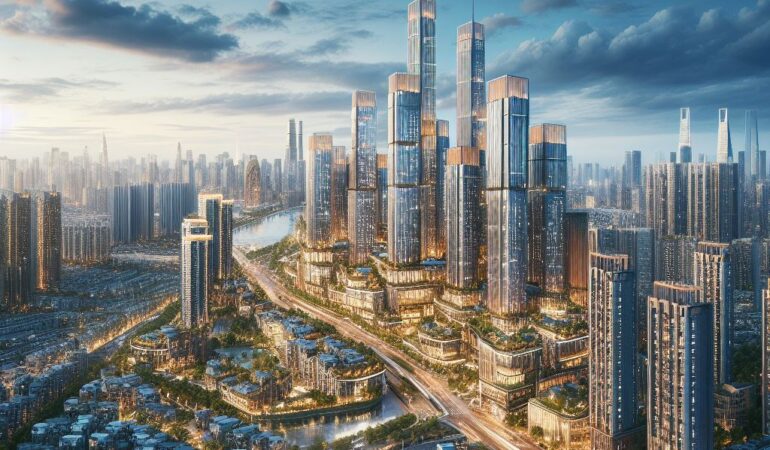Are you ready to make a savvy investment in the world of real estate? Look no further than this comprehensive guide on selecting prime apartment investment locations.
From economic growth and stability to demographic trends and rental demand, we’ll delve into the data and provide you with the insights you need to make an informed decision.
So, buckle up and get ready to uncover the hidden gems with the highest investment potential.
Let’s dive in!
Key Takeaways
- Evaluate GDP growth rates, employment rates, and industry diversification
- Analyze population size, age distribution, and migration patterns
- Assess rental demand to determine market saturation and potential for growth
- Evaluate proximity and quality of essential amenities such as grocery stores, schools, hospitals, and recreational facilities
Economic Growth and Stability
To ensure a successful apartment investment, you need to assess the economic growth and stability of potential locations. This step is crucial as it allows you to identify areas that have a strong foundation for long-term profitability. When evaluating the economic growth of a location, consider factors such as GDP growth rates, employment rates, and industry diversification. Look for areas that have experienced consistent economic growth over the years and have a diverse range of industries to reduce the risk of relying on a single sector.
Stability is equally important when choosing an investment location. Look for regions with a stable economy that’s resilient to market fluctuations. This stability can be assessed by analyzing factors such as inflation rates, housing market trends, and government policies. A stable economy can provide a solid foundation for your investment, ensuring a steady stream of tenants and potential for appreciation in property value.
By carefully evaluating the economic growth and stability of potential locations, you can make informed investment decisions that maximize your returns. Understanding the economic landscape of an area allows you to anticipate market trends, adjust rental prices accordingly, and make strategic long-term plans for your investment.
Now that we’ve discussed the importance of economic growth and stability, let’s delve into the next section: demographic trends and population growth.
Demographic Trends and Population Growth
When assessing prime apartment investment locations, you should focus on the demographic trends and population growth of potential areas. Understanding the demographic makeup of an area can provide valuable insights into the demand for rental properties and the potential for long-term growth.
Analyzing population growth trends can help you identify areas where the demand for housing is likely to increase, indicating a higher potential for rental income and property appreciation.
To evaluate the demographic trends and population growth of a potential investment location, you need to consider factors such as population size, age distribution, and migration patterns. Look for areas with a growing population, particularly in the prime renter age group of 25-34 years old. This indicates a higher demand for rental properties and a larger pool of potential tenants.
Additionally, consider the employment opportunities and economic growth of the area. Areas with strong job markets and growing industries are more likely to attract a younger population, which can contribute to a higher demand for rental properties.
By analyzing demographic trends and population growth, you can identify prime apartment investment locations that offer favorable rental market conditions and long-term growth potential.
This analysis sets the foundation for understanding the rental demand and occupancy rates in the subsequent section.
Rental Demand and Occupancy Rates
Consider analyzing the rental market conditions and occupancy rates when selecting prime apartment investment locations. Understanding the rental demand and occupancy rates in a specific area can provide valuable insights into the profitability and success of an investment.
Here are a few key reasons why this analysis is crucial:
- Market demand: Assessing the rental demand in a particular location helps determine whether there’s a high or low demand for rental properties. This data can inform your decision on whether the market is saturated or if there’s a potential for growth and higher rental yields.
- Occupancy rates: Examining the current occupancy rates in an area can indicate the level of competition among landlords. Higher occupancy rates suggest a healthy rental market and a higher likelihood of finding tenants quickly. Conversely, low occupancy rates may signal oversupply or other challenges that could affect your investment returns.
- Trends and forecasts: Analyzing historical rental market trends and forecasts can provide insights into the future demand and potential growth of a specific location. This data can help you identify areas that are likely to experience increased rental demand and higher occupancy rates, making them more attractive for investment.
Local Amenities and Infrastructure
Evaluate the proximity and quality of local amenities and infrastructure to ensure a desirable and convenient living experience for potential tenants. When considering a prime apartment investment location, it’s crucial to analyze the availability and accessibility of essential amenities such as grocery stores, schools, hospitals, and recreational facilities. A well-connected neighborhood with a range of amenities not only enhances the quality of life for residents but also attracts potential tenants.
Start by examining the proximity of grocery stores and shopping centers. A high-quality supermarket within a reasonable distance is essential for residents to conveniently access daily necessities. Additionally, a variety of retail options nearby can provide convenience and add value to the location.
Schools are another crucial factor to consider. Families with children often prioritize easy access to quality educational institutions. Research the proximity and reputation of nearby schools to gauge the potential demand for rental units in the area.
Access to healthcare facilities is also important for tenants. Evaluate the proximity and quality of hospitals, clinics, and pharmacies in the vicinity. Areas with reliable healthcare infrastructure tend to attract tenants seeking peace of mind and convenience.
Lastly, analyze the availability of recreational amenities such as parks, gyms, and entertainment venues. A neighborhood with access to green spaces and recreational facilities contributes to a desirable living experience and can attract a diverse range of tenants.
Market Analysis and Investment Potential
To assess the market analysis and investment potential for prime apartment locations, you should focus on researching and analyzing key factors. Here are some important considerations to keep in mind:
- Supply and demand: Investigate the current supply of apartments in the area and compare it to the demand. Look at occupancy rates, rental rates, and any trends in the market. A high demand and low supply can indicate a strong investment potential.
- Economic indicators: Analyze the economic factors that drive the local market. Look at job growth, population growth, and income levels. A thriving economy with positive indicators can lead to increased rental demand and higher returns.
- Development and infrastructure: Evaluate the development plans and infrastructure projects in the area. New transportation links, schools, and commercial developments can attract tenants and contribute to long-term growth.
By thoroughly analyzing these factors, you can determine the investment potential of a prime apartment location. Remember to gather reliable data, consult local experts, and consider any potential risks or challenges.
Making informed decisions based on market analysis will increase your chances of a successful and profitable investment.
Frequently Asked Questions
What Is the Average Rental Price for Apartments in These Prime Investment Locations?
The average rental price for apartments in these prime investment locations varies depending on factors such as location, size, and amenities. It is important to conduct thorough research and analyze data to make an informed decision.
Are There Any Upcoming Development Projects in These Areas That Could Impact Property Value?
Are there any upcoming development projects in these areas? It’s important to consider how these projects could impact property value. Stay informed and analyze the potential effects before making an investment decision.
What Are the Crime Rates Like in These Prime Apartment Investment Locations?
Are you wondering about crime rates in prime apartment investment locations? Let’s dive into the data and analyze the safety of these areas, providing you with a thorough understanding to make an informed decision.
How Accessible Are These Locations to Public Transportation and Major Highways?
When considering prime apartment investment locations, it’s essential to assess their accessibility to public transportation and major highways. This information will help you make an informed decision and ensure convenience for future tenants.
Are There Any Environmental Factors That Could Affect the Desirability of These Prime Investment Locations, Such as Pollution or Natural Disasters?
“Consider potential environmental factors when evaluating prime investment locations. Are there any pollution concerns or a history of natural disasters? These factors could impact desirability and long-term value. Conduct thorough research before making a decision.”




